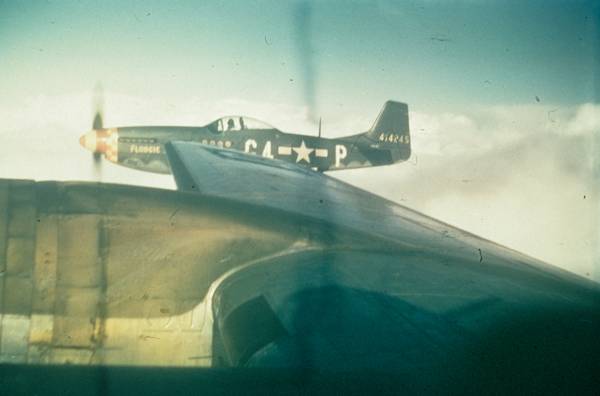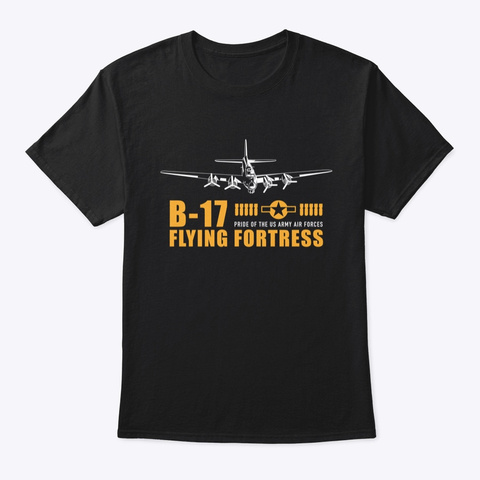B-17 Bomber Flying Fortress – The Queen Of The Skies The Bomber-Escort
 English
English Deutsch
Deutsch
“Only the spirit of attack borne in a brave heart will bring a success to any fighter aircraft, no matter how highly developed it may be.”
Luftwaffengeneral Adolf Galland

The job of the fighter escort squadrons was to give the heavy bombers maximum protection to an from their target. This meant that the escort planes had to be with the bombing force for as long as possible.
Each fighter squadron had three of four flights stepped down behind the lead flight; so that all could keep eye on the leader. Flights were kept 150 feet apart with individual aircraft from each flight keeping within 40 feet of each other.
As soon as they achieved formation, P-38 Lightnings and P-47 Thunderbolts immediately turned on their long distance drop tanks, while the P-51 Mustang had to use up about 30 gallons from its main tanks, to maintain balance, before turning to wing drop tanks.
Spurious fighter acticity on the way to the target had to to be avoided beacuase, in the event of combat, long distance drop tanks had to be jettisoned and the bomber fleet group, made up of three squadrons, was allocated to each Combat Wing box. One squadron divided and positioned itself ahead and above the bombers, another squadron also split and took up pisition above and about a mile away on eighter side of the formation. The last squadron climed 4000 feet directly above the force and ten miles into the sun in anticipation of the normal enemy fighter strategy of diving out of the sun’s glare.
![Bomber-Geleitschutz // Wikipedia Commons [Public Domain]](https://b17flyingfortress.de/cms/wp-content/uploads/2015/12/II_World_War_contrails-600x478.jpg)
“What frightened me every time so that the hair stood me by mountain was if our fighter escort-and high and runterflog and suddenly the tanks threw off and in any direction flew to and fro. I then knew that German fighters were nearby.”
Robert Davila, Pilot USAAF
The escort fighters weaved or orbited so that they could stay in touch with the slower bombers with pilots constatly scanning the skies for “bandits”. Although mirrors were fitted to cockpits, good fighter pilots were nicknamed “swivel heads” because they had to keep looking all around them at all times.

The fighter pilots could communicate with the bombers and warn each other of attacks or respond to calls for fighter help. Up until 1944 the prime objective of the fighter force was to stay with the bombers, but after January 1944, with the lessening power of the Luftwaffe, they were allowed to pursue the enemy further airfield.
The main combat tactics used by fighters of both sides were: using the sun’s glare to achieve surprise in diving attacks, turning into an enemy, tightening a turn to get behind him, rolling away and diving to escape a dangerous situation. But, as in all things, the tactics depended upon the aircraft’s performance capabilities.
Fighter Attack Description from Missing Air Crew Report File #3869
At 1354 hours, E/A again appearted in the vicinity of our Wing and P-47’s were reported to have dived down upon them. Immediately after our escort had left for the interception of the enemy fighters, a wave of fifteen (15) FW 190’s grey in color and with a fairly large red square painted on the side of the fuselage made a head-on attack from a great distance away, coming in slightly below and flying directly through and between out Lead and Low Squadrons.
These A/C broke to the right and progressed again ahead of the formation in trail. As they were continuing across the from of our formation, three (3) additional FW 190’s using the latter as a screen, suddenly broke beneath from them and dove again into our Low Squadron. During this attack, the Group Leader and six (6) additional aircraft of our Low Squadron were shot down.
Destructive action began in the leading element of the Low Squadron, and in clearing the formation and the explosing of our A/C that immediately followed, the Squadron was somewhat scattered and were successfully destroyed by FW 190’s, continuing to come throgh in staggered trail.
Fifteen (15) addtional long-nosed FW 190’s and 109’s attacked from slightly below between 11 and 12 O’Clock, passing through the area occupied by our Low Squadron. Between the times of 1354 and 1359 hours, it appears that no fighter escort was covering this group and that at about 1359½ hours, a Group of P-51’s showed up carrying dual belly gasoline tanks which were immediately dropped upon attacking the enemy. No further interceptions were made from this point on.
The above enemy action is estimated to have hasted only from 1354 to 1357 hours.





